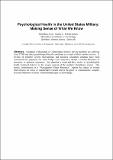| dc.contributor.author | Hess, John | |
| dc.contributor.author | Kamin, Cody | |
| dc.contributor.author | Kenley, C. Robert | |
| dc.date.accessioned | 2014-04-07T17:17:02Z | |
| dc.date.available | 2014-04-07T17:17:02Z | |
| dc.date.issued | 2011 | |
| dc.identifier.uri | http://hdl.handle.net/1721.1/86060 | |
| dc.description.abstract | Hundreds of thousands of United States military service members are suffering
from PTSD and other psychological health conditions as a result of their wartime service. A
myriad of possible system interventions and resource allocation schemas have been
researched and proposed, but finite budgets and manpower dictate a careful allocation of
resources to optimize outcomes. We describe a stock-and-flow model of psychological
health treatment tailored to the unique context of the military’s healthcare system. Our
model, implemented as a “Management Flight Simulator”, reports the impact of system
interventions on areas of stakeholder concern and is designed to communicate complex
systemic behaviors to those without domain specific knowledge. | en_US |
| dc.rights | Attribution-NonCommercial-ShareAlike 3.0 United States | * |
| dc.rights.uri | http://creativecommons.org/licenses/by-nc-sa/3.0/us/ | * |
| dc.subject | PTSD | en_US |
| dc.subject | psychological health | en_US |
| dc.subject | stock-and-flow | en_US |
| dc.subject | healthcare system | en_US |
| dc.subject | Management Flight Simulator | en_US |
| dc.title | Psychological Health in the United States Military: Making Sense of What We Know | en_US |
| dc.type | Presentation | en_US |
| dc.type | Technical Report | en_US |
